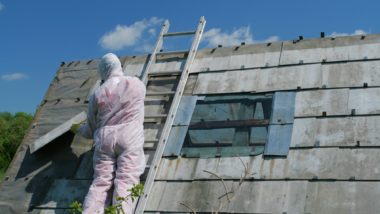Top Class Actions’s website and social media posts use affiliate links. If you make a purchase using such links, we may receive a commission, but it will not result in any additional charges to you. Please review our Affiliate Link Disclosure for more information.
Nearly four percent of lung cancer patients have developed asbestos-related lung cancer caused by asbestos exposure, a known carcinogen that can take decades before its damage becomes apparent.
What Is Asbestos?
Asbestos is a fibrous, friable mineral found in rocks and soil.
Although asbestos has been known and used since the days of the Roman Empire (the word “asbestos” comes from an ancient Greek term meaning “inextinguishable”), the material became popular during the Industrial Revolution because of its fire-resistant and insulating properties.
There are several varieties of asbestos that fall into one of two broad categories:
- Serpentine: also known as “white” asbestos or chrysotile, is by far the most commonly used type used in construction. These fibers are relatively soft and curly (hence the name), but can still cause serious lung damage, including internal scarring (known as asbestosis) and cancer. Serpentine asbestos is no longer mined and processed in the U.S. However, U.S. industries continue to import raw asbestos legally from countries such as China, India, and Brazil.
- Amphibole: there are a number of different types of asbestos that fall into this category, although only two of them – crocidolite (“blue” asbestos) and tremolite (“brown” asbestos) were commonly used, primarily for electrical insulation. These fibers are particularly dangerous, being made up of microscopic needles that literally drill their way through organ tissues from the inside out when ingested, causing chronic inflammation. These fibers are known to cause mesothelioma (see below). The use of amphibole asbestos has been banned in most Western countries as well as Japan.
If I Can’t See Asbestos Fibers in the Air, Am I Safe?
Asbestos fibers can be microscopically small, and because they are so light, they can float in the air for extended periods of time (in this state, it is known as “friable”). Breathing in these tiny fibers will allow them to become embedded in the lungs, where they fester and can eventually give rise to lung cancer.
While the risk of asbestos cancer increases with more exposure, it is important to note that, according to the Occupational Safety and Health Administration (OSHA), “there is no ‘safe’ level of asbestos exposure for any type of asbestos fiber.”
 Is Lung Cancer Caused by Asbestos the Same Thing as Mesothelioma?
Is Lung Cancer Caused by Asbestos the Same Thing as Mesothelioma?
No. Pleural mesothelioma is a cancer of the pleura, which is the lining of the lungs. Lung cancer caused by asbestos or from any other toxin develops inside the lung tissue. Mesothelioma can develop in tissues of the visceral lining surrounding other organs as well, including the stomach and digestive tract, pelvic organs and even the heart.
While lung cancer appears 15 to 35 years after a person is exposed to asbestos, mesothelioma takes even longer to develop. Mesothelioma may take between 20 and 50 years to develop.
If a patient develops cancer from asbestos exposure, doctors must determine if the disease is mesothelioma or lung cancer. Some elements of their symptoms are similar, which can make it challenging to distinguish between the two conditions. Identifying early symptoms is a key method of treating mesothelioma, lung cancer caused by asbestos, or any other type of cancer.
Both mesothelioma and lung cancer can present with the buildup of fluid in the chest cavity known as plural effusion. This similarly can make it challenging to distinguish between mesothelioma and lung cancer. However, mesothelioma is associated with pleural thickening, whereas lung cancer is not. Pleural thickening is an occurrence when the lining of the lungs thicken because scar tissue builds up.
Lung cancer is the second most common kind of cancer, with 222,500 new cases developing annually. Mesothelioma, on the other hand, is associated with only 2,800 cases each year.
Lung cancer is most often attributed to smoking, with 90% of its cases associated with the dangerous habit. In contrast, almost all cases of the much rarer condition, mesothelioma, are deemed to be linked to asbestos exposure. This means that if a patient develops lung cancer, it could be linked to a range of factors, including asbestos exposure. However, if a patient develops mesothelioma, it is almost always attributed to asbestos exposure that occurred earlier in life.
How Could I Have Been Exposed to Asbestos?
Asbestos-based products are resilient because of resistance to heat, chemicals, and electricity. Many types of construction materials, railroad and ship insulation, and vehicle parts make use of asbestos. Vinyl tile flooring, wall and attic insulation, shingles, siding, insulated blankets around hot water pipes, and car brake pads could all contain asbestos fibers. Anyone who worked with these products could be at risk for asbestos lung cancer.
Although asbestos is banned, it is still a threat to many workers. The American Cancer Society says that the U.S. Occupational Health and Safety Administration (OSHA) estimates more than one million American workers in construction and other heavy industries could be exposed to asbestos on job sites.
Asbestos exposure can also occur secondhand, such as when a worker who has been exposed to asbestos brings home asbestos fibers on their clothes or body. If a worker wears home the clothing that he worked in while doing work around asbestos, those fibers cling to the clothing and potentially expose others in the household. If the person who washes the clothes shakes off the dust before placing the clothes into the washing machine, the airborne fibers are easily inhaled.
In addition, anyone who has served in the military could have been exposed to asbestos.
How Could Someone in the Military Incur Asbestos Exposure?
Current and former members of the military could develop lung cancer caused by asbestos among many other asbestos-related diseases.
According to the Veterans Administration, the following situations could have exposed service members to asbestos:
- Service members who helped renovate or remove asbestos materials before or after 1970 could become ill.
- Navy ships with keels laid prior to 1983 pose a risk of asbestos exposure to any Navy veteran who served on such a vessel.
- Navy veterans who worked in shipbuilding any time between the 1930s to the 1990s could suffer from asbestos-related diseases because the material was heavily used during those decades.
- Any members of the Navy who were assigned below deck before the 1990s were apt to be exposed to asbestos fibers because the ventilation was often insufficient.
- Service members who worked as pipefitters, welders, boilermakers, building renovation or demolition workers, or were around while any work of such type was ongoing before the mid-1990s could have been exposed to significant amounts of asbestos dust.
In many cases, Navy personnel were assigned asbestos removal in engine rooms. They had to re-wrap pipes with the help of an asbestos-based paste. Often times, no respiratory protection or other protective gear was provided.
A person exposed to asbestos is more apt to suffer adverse health consequences the longer they have been exposed to the carcinogen. People who smoke are at a higher risk of asbestos-related diseases, as are those who suffer from any type of pre-existing lung condition.
How Can a Doctor Tell if I have Asbestos-Caused Lung Cancer?
Asbestos-caused lung cancer may not develop for 15 to 35 years after exposure. This may make it difficult for doctors to accurately tell if a patient’s lung cancer is linked to asbestos.
Since 1997, doctors have used the Helsinki Criteria to determine whether a patient’s lung cancer originated through asbestos exposure. If the lung cancer developed at least a decade after asbestos exposure and if the patient was exposed to airborne asbestos fibers equal to or more than 25 fibers per milliliter per year, the patient is apt to have lung cancer linked to that asbestos exposure.
The lung tissue might be tested for asbestos fibers, and the diagnosis of asbestosis, which means the lungs are heavily scarred from asbestos fibers, comes into the equation, too.
Can I File an Asbestos Cancer Lawsuit?
A growing number of plaintiffs are coming forward with allegations of asbestos-related cancer diagnoses, including lung cancer. Plaintiffs often claim that they were exposed to asbestos through their workplaces and were not adequately warned about the harmful substance, nor given adequate protection against it. Others may have been exposed to asbestos second-hand.
Hundreds of thousands of asbestos claims have already been filed against thousands of defendants, making asbestos litigation one of the largest mass torts in U.S. history. In some cases, asbestos litigation has ended with settlement awards in the millions.
If you or someone you love has been diagnosed with an asbestos-related disease like lung cancer, you may be able to file a lawsuit and pursue compensation. Of course, filing a lawsuit cannot take away the pain and suffering caused by a cancer diagnosis, nor can it bring a loved back to life, but it can at least help to alleviate the financial burden incurred by medical expenses and lost wages.
Filing a lawsuit can be a daunting prospect, especially in the wake of a cancer diagnosis, so Top Class Actions has laid the groundwork for you by connecting you with an experienced attorney. Consulting an attorney can help you determine if you have a claim, navigate the complexities of litigation, and maximize your potential compensation.
ATTORNEY ADVERTISING
Top Class Actions is a Proud Member of the American Bar Association
LEGAL INFORMATION IS NOT LEGAL ADVICE
Top Class Actions Legal Statement
©2008 – 2024 Top Class Actions® LLC
Various Trademarks held by their respective owners
This website is not intended for viewing or usage by European Union citizens.
Get Help – It’s Free
Join a Free Asbestos Cancer Class Action Lawsuit Investigation
If you qualify, an attorney will contact you to discuss the details of your potential case at no charge to you.
PLEASE NOTE: If you want to participate in this investigation, it is imperative that you reply to the law firm if they call or email you. Failing to do so may result in you not getting signed up as a client or getting you dropped as a client.
E-mail any problems with this form to:
Questions@TopClassActions.com.
Oops! We could not locate your form.


 Is Lung Cancer Caused by Asbestos the Same Thing as Mesothelioma?
Is Lung Cancer Caused by Asbestos the Same Thing as Mesothelioma?









